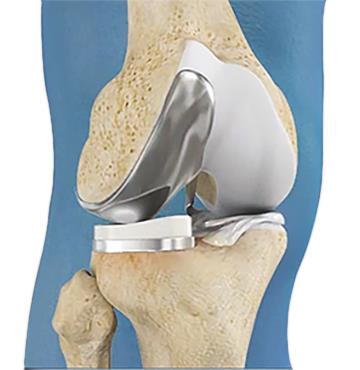
What is Oxford Unicompartmental Knee Replacement?
The Oxford unicompartmental knee replacement, also called Oxford mobile-bearing knee replacement and Oxford medial unicompartmental knee replacement, is a type of partial knee replacement where the damaged knee joint, usually the medial knee compartment, is replaced with an Oxford mobile-bearing knee implant. Thus, the rest of your healthy knee is preserved in its natural state.
What is Anatomy of the Knee?
The knee is divided into three compartments:
- Lateral: outer part of the knee
- Medial: inner part of the knee
- Patellofemoral: front portion of the knee, between the kneecap (patella) and thighbone (femur)
What are the Components of Oxford Partial Knee?
The Oxford Partial Knee consists of two components – the tibial and femoral implants, which are supported by mobile bearings. It is made up of biocompatible metal and plastic. The Oxford Knee implant is available in different sizes to provide an optimal fit for unique anatomies of individual patients.
What are the Indications and Contraindications for Oxford Unicompartmental Knee Replacement?
The Oxford Unicompartmental Knee Replacement is an alternative to the total knee replacement procedure and is recommended for patients with unicompartmental osteoarthritis or osteonecrosis, where nonsurgical treatment is unsuccessful.
Oxford Unicompartmental Knee Replacement is contraindicated for rheumatoid arthritis and severe infection (sepsis).
How is Oxford Unicompartmental Knee Replacement Performed?
The Oxford Unicompartmental Knee Replacement surgery is performed under either spinal or general anesthesia.
You will be placed in a supine position - face-up - with one leg bent at about 30 degrees and the other leg extended on the operation bed.
The Oxford Unicompartmental Knee Replacement is a minimally invasive surgery performed using the following steps:
- Incision: The area to be operated on is marked and a cut is made in the specific section of the knee to access the damaged joint.
- Preparing the bone: The damaged cartilage and the surrounding soft tissues are removed.
- Drilling: Your surgeon drills small holes in the tibia and femur guided by pre-surgical measurements to place the fixation screws.
- Insertion of the implant: The space in your knee joint is replaced with the Oxford Knee Implant. The mobile-bearing implant is secured using cement.
- Closing the incision: The incision is closed with stitches.
The entire surgery may take 1 to 2 hours.
What Does Postoperative Care forOxford Unicompartmental Knee Replacement Involve?
Post-surgery, you will be monitored and discharged after 1 to 3 days. In some cases, patients may be discharged on the day of surgery. Post-operative imaging tests are usually ordered to determine the success of your knee surgery.
- You will be prescribed pain medications to keep you comfortable.
- You will be encouraged to walk immediately after surgery. Crutches, a walker, or a cane will be needed for weight-bearing in the first few weeks.
- Perform mild exercises as per your physiotherapist’s recommendations to remain active. Depending on the pace of your recovery, you should gradually increase the intensity of your regular activities.
- Complete recovery may take up to 6 weeks.
What are the Advantages of Oxford Unicompartmental Knee Replacement?
The advantages of Oxford Unicompartmental Knee Replacement over total knee replacement include less blood loss, faster recovery, and less post-operative pain since it is performed through a small incision. Your knee will feel more natural as the healthy parts of the knee are retained.
What are the Risks and Complications of Oxford Unicompartmental Knee Replacement?
As with most surgical procedures, Oxford Unicompartmental Knee Replacement may be associated with the following complications:
- Injury to neighboring blood vessels or nerves
- Dislocation of the patella (kneecap) or implant
- Knee pain
- Infection
- Blood clots in the knee or leg
- Bone fracture
- Requirement of additional surgery

